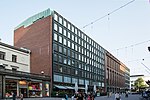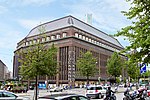Swedish Theatre
1827 establishments in the Russian Empire1866 establishments in the Russian EmpireCommercial buildings completed in 1860Commercial buildings completed in 1866Eero Saarinen structures ... and 4 more
KaartinkaupunkiNeoclassical architecture in FinlandOrganizations established in 1827Theatres in Helsinki

The Swedish Theatre (Swedish: Svenska Teatern) is a Swedish-language theatre in Helsinki, Finland, and is located at the Erottaja (Swedish: Skillnaden) square, at the end of Esplanadi (Swedish: Esplanaden). It was the first national stage of Finland.
Excerpt from the Wikipedia article Swedish Theatre (License: CC BY-SA 3.0, Authors, Images).Swedish Theatre
Pohjoisesplanadi, Helsinki Kaartinkaupunki (Southern major district)
Geographical coordinates (GPS) Address External links Nearby Places Show on map
Geographical coordinates (GPS)
| Latitude | Longitude |
|---|---|
| N 60.167222222222 ° | E 24.943333333333 ° |
Address
Svenska Teatern
Pohjoisesplanadi 2
00130 Helsinki, Kaartinkaupunki (Southern major district)
Finland
Open on Google Maps










